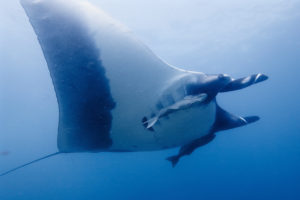 Marine biologists in Texas announced that they have found the
Marine biologists in Texas announced that they have found the
first known nursery for manta rays in the world. As the name implies, a nursery is a habitat for juvenile members of a given species, and it is usually near a coast or reef. The researchers found the nursery at the Flower Garden Banks National Marine Sanctuary along the Texan coast.
Joshua Stewart was the lead author of the scientific paper describing the nursery, which was originally published in the scientific journal “Marine Biology.” He described the juvenile stage of the manta ray as a “black box,” because very little is known about it. Finding the nursery will enable researchers to study the juvenile rays. It will also help conservation efforts, for manta rays are considered a threatened species throughout the world. Adults live in the open ocean, and researchers have found it hard to follow them back to their nurseries. Mantas will sometimes dive deep to feed on deep-sea plankton.
There are at least two known species of manta ray, the giant oceanic manta ray (Manta birostris) and the reef manta ray (Manta alfredi). The aptly-named giant oceanic manta ray, which is the biggest ray in the world, can have a “wingspan” of over 23 feet (seven meters), while the reef manta ray is typically about 18 feet (5.5 meters) wide.
Local researchers had commented on the comparatively small size of the rays at the sanctuary. When Stewart and his colleagues investigated 25 years of photo records and dive logs, they found that 95 percent of the rays were smaller than the average young adult male giant oceanic manta ray, and that 80 percent were smaller than the average reef manta ray that had just reached adulthood. In fact, the average specimen was no more than 7.38 feet (2.25 meters) across. Similarly, when the researchers examined photographs of the male rays, they found that many had undeveloped claspers (reproductive organs).
Manta rays are cartilaginous fish like sharks and, like sharks, they have a long lifespan and mature slowly. Mantas can live for approximately 40 years, and they reach maturity at around the age of eight. Consequently, it will take time for their populations to recover.


